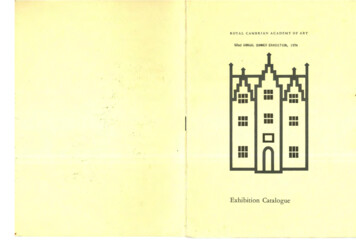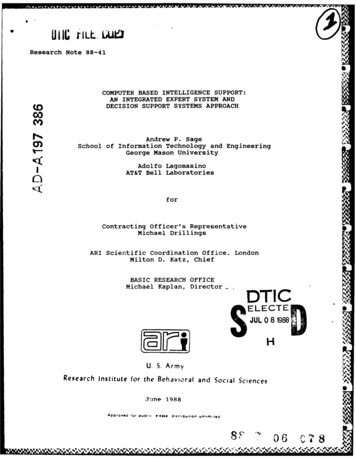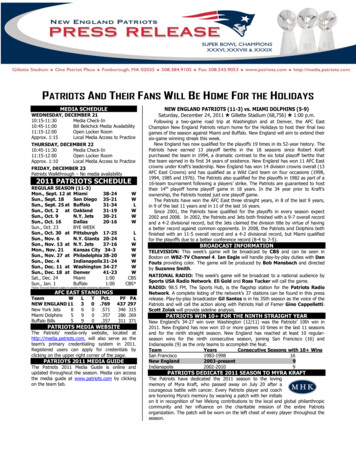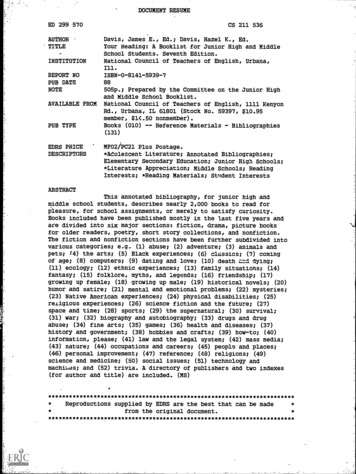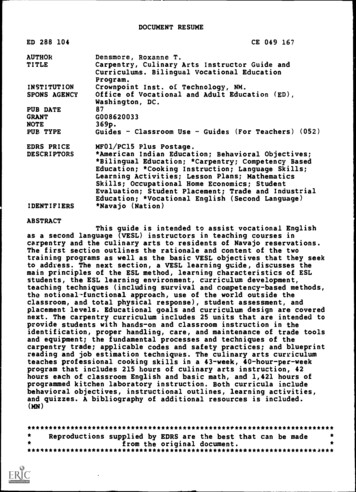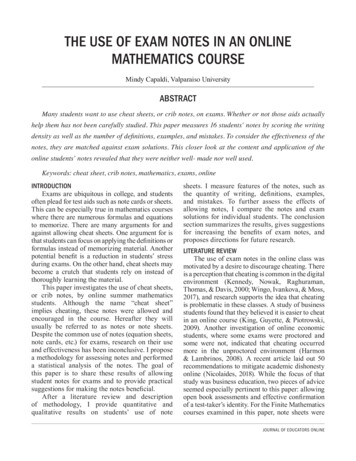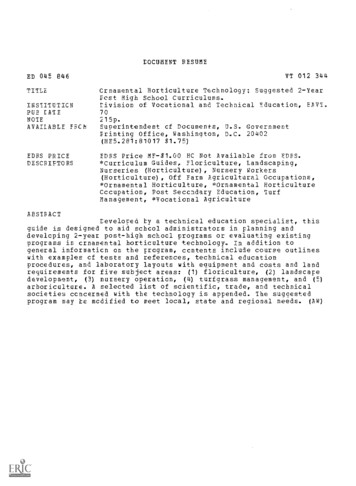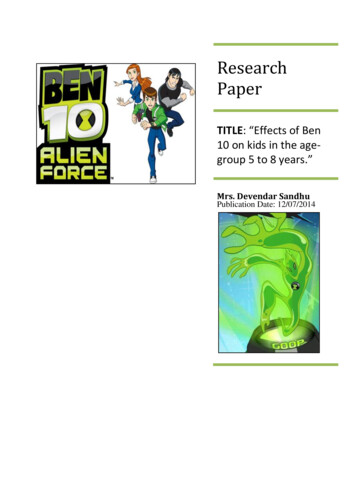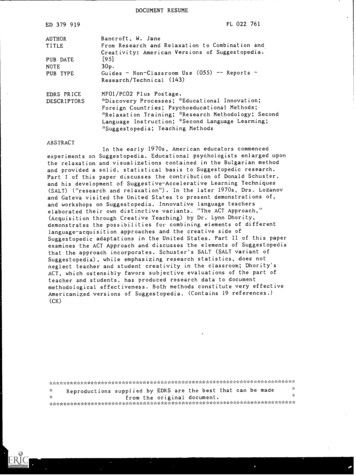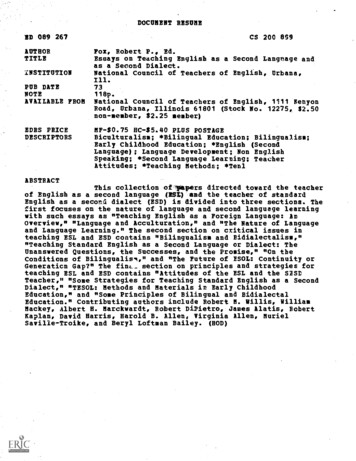
Transcription
DOCUMENT RESUMEED 089 267AUTHORTITLEINSTITUTIONPUB DATENOTEAVAILABLE FROMEDRS PRICEDESCRIPTORSCS 200 899Fox, Robert P., Ed.Essays on Teaching English as a Second Language andas a Second Dialect.National Council of Teachers of English, Urbana,Ill.73118p.National Council of Teachers of English, 1111 KenyonRoad, Urbana, Illinois 61801 (Stock No. 12275, 2.50non-member, 2.25 Member)MF- 0.75 HC- 5.40 PLUS POSTAGEBiculturalism; *Bilingual Education; Bilingualism;Early Childhood Education; *English (SecondLanguage); Language Development; Non EnglishSpeaking; *Second Language Learning; TeacherAttitudes; *Teaching Methods; *TentABSTRACTThis collection of Wipers directed toward the teacherof English as a second language (ESI) and the teacher of standardEnglish as a second dialect (ESD) is divided into three sections. Thefirst focuses on the nature of language and second language learningwith such essays as "Teaching English as a Foreign Language: AnOverview," "Language and Acculturation," and "The Nature of Languageand Language Learning." The second section on critical issues inteaching ESL and ESD contains "Bilingualism and Bidialectalism,""Teaching Standard English as a Second Language or Dialect: TheUnanswered Questions, the Successes, and the Promise," "On theConditions of Bilingualisl," and "The Future of ESOL: Continuity orGeneraticn Gap?" The fine section on principles and strategies forteaching ESL and ESD contains "Attitudes of the ESL and the SZSDTeacher," "Some Strategies for Teaching Standard English as a SecondDialect," "TESOL: Methods and Materials in Early ChildhoodEducation," and "Some Principles of Bilingual and BidialectalEducation." Contributing authors include Robert N. Willis, WilliamMackey, Albert H. Marckwardt, Robert DiPietro, James Alatis, RobertKaplan, David Harris, Harold B. Allen, Virginia Allen, MurielSaville-Troike, and Beryl Loftman Bailey. (HOD)
u.s.oePEDUCATIONEWILPAIII.NATIONAL INSTITUTE 011EDUCATIONTHIS DOCUMENT HAS BEEN REPRO.DUCED EXACTLY AS RECEIVED FROMTHE PERSON OR ORGANIZATION ORIGINATING IT. POINTS OF VIEW OR OPINIONSSTATED DO NOT HECESSAI4ILY REPRESENT OFFJCIAL NATIONAL INSTITUTE OFEDUCATION POSITION OR POLICYESSAYS dited by Robert P. FoxDirector, English Language InstituteThe American University
NCTE COMMITTEE ON PUBLICATIONS Robert F. Hogan, Blyden Jackson,Robert E. Pa lazzi, Bette J. Pe hole, Paul O'Dea/STAFF EDITOR AnnWarren/STAFF DESIGNER Norma Phillips MeyersCONSULTANT READERS James W. Ney, Arizona State University; VirginiaP. Rudd, Baltimore City Public Schools; Ronald Wardhaugh, English LanguageInstitute, University of MichiganLibrary of Congress Catalog Card Number 73-80964ISBN 0-8141-1227-5f/CTE Stock Number 12276Copyright 1973 by the Nations/ Council of Teachers of English.All rights reserved. Printed in the United States of America."PERMISSION T6 REPRODUCE THIS COPY-TO ERIC AND ORGANIZATIONS OPERATINGRIGHTED MATERIAL :4A5 BEEN GRANTED BYUNDER AGREEMENTS WITH THE NATIONAL IN-National Council ofTeachers of EnglishDUCTION OUTSIDE THE ERIC SYSTEM REWIRES PERMISSION OF THE COPYRIGHTSTITUTE OF EDUCATION. FURTHER REPRO-OWNER."
Contents4PrefaceRobert P. FoxDirector, English Language InstituteviiThe American University1. THE NATURE OF LANGUAGE AND SECOND LANGUAGE LEARNINGTeaching English as a Foreign Language: An OverviewRobert M. WillisNew York University3Language and AcculturationWilliam Francis MackeyLe all University8The Nature is f Language and of Language LearningAlbert H. MarckwardtPrinceton University232. CRITICAL ISSUES IN TEACHING ESL AND ESDBilingualism and BidialectalismRobert J. Di PietroGeorgetown UniversityTeaching Standard English as a Second Language or Dialect:The Unanswered Questions, the Successes, and the PromiseJuMeS E. AlatisGeorgetown UniversityOn the Conditions of Bilingualism354357Robert B. KaplanUniversity of Southern California, Los AngelesThe Future of ESOL: Continuity or Generation Gap?David P. HarrisDirector, American Language InstituteGeorgetown University67
3. PRINCIPLES AND STRATEGIES FOR TEACHING ESL AND ESDAttitudes of the ESL and the SESD TeacherHarold B. AllenUniversity of MinnesotaSome Strategies for Teaching Standard English asa Second DialectVirginia F. AllenTemple University8592TESOL: Methods and Materials in Early Childhood EducationMuriel R. Saville-TroikeCenter for Applied Linguistics102Some Principles of Bilingual and Sidle lectal EducationBeryl Loftman BaileyHunter College107Bibliography115
PrefaceIn the spring of each year, the National Council of Teachers ofEnglish sponsors a series of institutes concerned with some aspect ofEnglish. The spring institutes held in Tallahassee, Albuquerque, andAlbany in the early seventies were directed at a highly specializedaudiencethe teacher of English as a second language and the teacherof standard English as a second dialect. Some 250 participants cametogether for intensive three-and-a-half-day institutes, in which theylistened, discussed, debated, argued, and, hopefully, learned.NCTE has long been interested in the teaching of English as asecond language, and was one of the sponsors of a series of conferencesthat led to the establishment in 1966 of a new professional organizationthe Teachers of English to Speakers of Other Languages (TESOL).The creation of TESOL resulted in a clearinghouse for the exchangeof ideas by teachers at all levels of education who, with the exceptionof university teachers, had been more or less left to their own devices.(In the case of the university teachers, the Association of Teachersof English as a Second Languagea section of the National Associationfor Foreign Student Affairs, an organization devoted to the interestsof foreign students on American university ompusesfunctioned asa clearinghouse and meeting ground.) NCTE, since the inception ofTESOL, has not limited its interest in "seconds" to English as a secondlanguage, but has become actively involved in the study and concernsof teaching standard English as a second dialect. It is this ongoinginterest of NCTE in English both as a second language and as a seconddialect that prompted it to sponsor this series of spring institutes.The beginning of a new decade, 1970, was an ideal time for theprofession to pause and take stock of itselfits past and future. Thelinguistic revolution started by Noam Chomsky in the late 1950s hadaffected and changed the philosophy of many teachers of English asa second language. The civil rights movement culminating in the sixtiesalso brought to the fore the question of second dialect teaching. Itwas assumed that the two "seconds" were compatible and that themethods of teaching English as a second language would be effectivein teaching English as a second dialect.
viiiPrefaceThe marriage in this institute of English as a second languageand standard English as a second dialect proved to be a most interestingonethough a shaky and at times shaking one. The teaching of Englishas a second language was accepted, discussed, and debated by all theparticipants. However, the very validity of the idea of teaching standardEnglish as a second dialect was questioned. Some defended it as beinga necessary evil created by an economic system that d"nanded somesort of functional bidialectalism. Others described it as the creationof a racist society. To complicate the situation further, there wasconsiderable disagreement as to what standard English was, if indeedsuch a thing existed at all.Professor Sol Saporta of the University of Washington, in the abstractof his talk "Language and Racism," has probably stated most succinctlythe problems inherent in the teaching of one dialect of English tospeakers of another dialect: "There are essentially four views one cantake regarding the teaching of one dialect of English to speakers ofanother dialect, for example the teaching of so-called standard Englishto speakers of black English. (1) Speakers of black English are 'verballyimpoverished.' Their language is inherently incapable of expressingeither complex or abstract thoughts; to a certain extent, therefore,they may be viewed as hardly having a language at all, and exposingthem to English is in effect exposing them to a 'bona fide' languagefor the first time. (2) Black English is a dialect of English with itsown system of rules, which, however, is socially unacceptable. It istherefore in the best interest of blacks to replace their dialect of Englishwith one that iF acceptable. (3) Black English is a dialect of Englishwhich is appropriate under one set of circumstances, but it must besupplemented by standard English in order for blacks to functionsuccessfully in society at large."It is important to realize that all three of these views are reflectionsof society's racism, and that the difference between the first view andthe other two is only that the former is, in addition, linguisticallyuntenable."The question facing society in general and educational institutionsin particular is how to provide blacks (and whites) with the necessaryskills without catering, explicitly or implicitly, to the racism whichpermeates society. An assumption which might provide the basis fca.an alternative position is this: (4) It is possible to teach a speaker ofany dialect the skills of reading and writing, in his dialect, withoutimplying that he must somehow change the way he speaks."There were three major areas of concern at the institutes, all ofwhich are interdependent. The speakers and participants examinedin depth the nature of language and language learning, especially asit related to the teaching of English as a second language or seconddialect. They examined, too, the critical issues involved in the teachingof English as a second language (ESL) and English as a secead dialect
ixPreface(ESD), and tried to come to grips with the problems, both moral andhumanistic, of teaching the latter. This led to the deeper issues oflanguage and racism, and of whether ESL and ESD should even beconsidered as related disciplines. In examining the third concern, theprinciples and strategies for teaching English as a second languageand standard English as a second dialect, the participants were againdivided as to whether second language techniques could effectivelybe used in second dialect teaching, if indeed we should even concernourselves with second dialect work.The conclusions reached in these three areas were as varied aswere the institute participants themselves, but each individual left witha greater awareness of and sympathy for the problems of his fellowparticipants.The papers read at the institutes are presented here, edited slightlyfor print and grouped according to the three major areas of concern,to focus the reader's attention on the theoretical and practical issuesconfronted at the institutes. These papers provide an excellent overviewof the past, an insight into the problems of the present, and somehope for solutions in the future. The institutes provided the impetusfor change which it is hoped many of the participants were able toeffect in their own situations, and since many of the problems existingat the time of the institutes still exist today, hopefully the papers inthis small volume will provide the same incentive for the reader tocome to grips with those problems.As director of the institutes, with the responsibility for selectingthe speakers and preparing their papers for publication, I am allowedto put my name in this book; however, any credit for the success ofthe institutes or of this book must be shared with a man who seesno task as impossible and no obstacle as too great to overcome. Thisman is Rod Morisset, Assistant Executive Secretary of the NationalCouncil of Teachers of English, who was the guiding force of theinstitutes. When sickness prevented him from being in Tallahassee andAlbuquerque, he was represented by two very capable members ofthe NCTE staff, Richard Adler and Raymond Crisp.The local chairmenRichard Lee for the Tallahassee Institute,Robert White for the Albuquerque Institute, and Ruth Blackburn forthe Albany Instituteplanned well and met the inevitable emergencieswith energy, good sense, and good humor. Not only the efforts ofall these individuals, but also the efforts of those presenting papers,made the institutes "experiences" for all who participated.Robert P. FoxThe American University
41THE NATURE OF LANGUAGEAND SECOND LANGUAGE LEARNING
Teaching Eng list, as a Foreign Language:An OverviewRobert M. WillisThe application of the theories of linguistic science to the teachingof English as a foreign or second language has been increasing steadilysince the 1940s. Previously in the United States, foreign languageteaching had been generally carried on through the "grammar-translation" method which required the student to memorize rules, conjugations, and vocabulary lists. Proof of the validity of this method wasbased on the fact that some students were able to recite isolated wordforms, pass written tests, and translate sentences from English intothe foreign language and from the foreign language into English. Butbeginning iP the forties with the work of such linguists as CharlesC. Fries, the emphasis turned increasingly toward applying linguistictheories to teaching English as a second language. Dr. Fries' contributionis evident when one examines the research and writing of the structurallinguists of that time. Teachers too were influenced, and the followingstatement reflects the attitude that had gained popularity by the early1960s: "In recent years linguistic studies have radically altered languageteaching. The traditional method of learning a new language by studyingprinted words and the rules governing their arrangement has beenlargely replaced by the audiolingual approach. Language is now considered as a set of speech habits and the rules of grammar as a descriptionof these habits. Thus, today, language is taught essentially as a toolof verbal communication. "'This approach to language learning as a tool of verbal communication gained impetus during World War II when the UnitedStates government needed personnel with a practical knowledge offoreign languages. According to Fries, this need could not be satisfiedto any significant degree from the ranks of college graduates whohad studied foreign languages under the "grammar-translation" method.' Therefore, it became necessary for the government to set up its'Audrey Wright, "Initial Techniques in Teaching English as a Second Language,"The ABC English as a Second Lanr,tage Bulletin, vol. 1, no. 2, 1964.2Charles C. Fries, Teaching and Learning English as a Foreign Language (Ann Arbor:The University of Michigan Press, 1945).
4An Overviewown language training programs for military and civilian personnelwho would be working in various parts of the world With people whospoke foreign languages. "After the war, the widespread use of taperecorders and other audio devices made it possible to provide authenticspoken models of foreign language as substitutes for native informantsused in the government training sessions. This technique together withcontrastive studies of the target and the native languages, written forthe language teacher, brought the linguistic approach to a high levelof effectiveness."'The theories and techniques of the linguistic approach have beenreceived with criticism as well as with praise. Wilga Rivers, for one,challenges not only the results but also the basic assumptions of the"pattern-practice" method.4 It can be stated without fear of vehementcontradiction that pattern practice in the public schools did not achievethe success attributed to the government language programs. However,it must be admitted that the "linguistic" method started off in thepublic schools under extremely difficult circumstances, to say the least.As the students studying English as a foreign language in our schoolswere not an academically select group (as were the United States militaryand government trainees), and as they did not have the motivation(career, rank, and so forth) of the trainees, nor the time requiredfor highly intensive study, it was unrealistic to expect results comparableto those achieved under the very special wartime situation. However,experience with the "new" approach revealed a great deal about theteaching and learning process for non-native speakers of English. Amongthe most significant lessons learned were that new and better materialsmust be developed, that teachers must be educated and trained inthe dynamics of second language learning, and that teaching aids suchas tape recorders, language labs, and visual aids in themselves cannotachieve success. The value of such aids depends upon how effectivelythey have been made an integral and productive part of the methodbeing employed.This brief statement of past events should serve as a partial frameof reference for the present debate in teaching English as a foreignlanguage or for foreign language teaching in general. There aretextbooks in French, Spanish, Italian, and so forth that use patternpractice as part of their methodology and therefore are targets in thenew controversy. Although there are textbooks published recently whoseauthors indicate their awareness of the need to move beyond patternpractice, it is extremely difficult to find a textbook that has successfullyachieved this goal and received widespread acceptance or rejection3 Robert Lado, Language Teaching (New York: McGraw-Hill, 1964), p. 6.4Wili%a M. Rivers, The Psychologist and the Foreign Language Teacher (Chicago. TheUniversity of Chicago Press, 1964).
5Robert M. Willisby the teachers who have examined or used such texts. My experienceas a supervisor and consultant in TESOL (Teachers of English toSpeakers of Other Languages) has permitted me to discuss texts andmaterials with a wide variety of teachers in extremely diverse situations.Equally determined supporters or detractors can be found for the FriesSeries, the Lado Series, the English 900 Series, the Grant Taylor texts,the Dixson texts, and a variety of others. Teachers seem to be constantlysearching for the "perfect" textbook, yet it must be understood thatthere can be no textbook that would be "perfect" for all teachers. Atextbook is "perfect" only to the extent to which it satisfies the needsof a particular teacher and a particular situation, and no two situationswill be exactly the same. Students vary, their needs differ, and teachersrepresent a multitude of personalities and a cross section of training.However, there is at least one thing that can be said to be commonto all language teaching, and that is the desire to have the studentlearn the language being taught. Oddly this apparent cliche at timesseems to be the bond that permits opponents to continue to talk toeach other.It is the question of how a language can best be learned and bestbe taught that in part has generated the current controversy. As statedpreviously, Wilga Rivers expresses serious reservations regarding theclaims made for the effectiveness of pattern practice in foreign languagelearning. And Noam Chomsky, in his statements at the NortheastConference of 1966, challenged the validity of the direct and uncriticalapplication of linguistic theory to teaching languages: "I am, frankly,rather skeptical about the significance for the teaching of languages,of such insights and understanding as have been attained in linguisticsand psychology."' He also said that, "It is possibleeven likelythatprinciples of psychology and linguistics, and research in these disciplines,may supply insights useful to the language teacher. But this must bedemonstrated, and cannot be presumed. It is the language teacherhimself who must validate or repute any specific proposal. There isvery little in psychology or linguistics that he can accept on faith."'The theory held by structuralists is in part set forth in the follo
University of Minnesota 85. Some Strategies for Teaching Standard English as a Second Dialect 92 Virginia F. Allen Temple University. TESOL: Methods and Materials in Early Childhood Education. 102. Muriel R. Saville-Troike Center for Applied Linguistics. Some Principles of Bilingual and Sidle lectal Education. 107. Beryl Loftman Bailey. Hunter .
